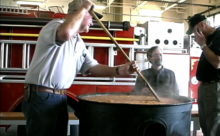Woodward on the Making of "The Sheep Stew of Dundas"
Written by Woodward to supplement his 2015 interview with Saddler Taylor and Tom Davenport.
This was the most esoteric, most unusual, and most rare stew in the Brunswick stew family that I documented while shooting the Virginia Brunswick stew story in that state. While filming the Brunswick stew I had learned of a sheep stew cooked for the Red Oak Ruritan Club by the Stewmaster, Mr. John Clay, Jr. Sheep stew, I learned, was cooked in only three small towns--Dundas in Lunenburg County and Danieltown and Kenbridge across the line in Brunswick County. Go twenty miles in any direction from any of these towns and no one will have heard of sheep stew.
I traveled to Dundas one Sunday morning and figured that by attending the largest church there I might make contact with folks who knew something about the stew. Before the service, as men were coming up the stairs from Sunday School to attend the worship service, I stopped one, told him about my documenting the Virginia Brunswick stew story, and said I had been told that I needed to come to Dundas and find out about Sheep stew. It turned out that the man I asked was the president of the Dundas Ruritan club. He invited me to join his family for lunch after church, there I learned the history of sheep stew.
I was told that sheep were plentiful on farms in the area, and the stew was made from the mutton of old sheep no longer useful for reproduction. Sheep stew was patterned after the method used in cooking the original Brunswick stew--first made, tradition says, by a black camp cook, a freedman who worked for a Colonel Creed Haskins of Brunswick County back in 1828 on the banks of the Nottoway River. The original Brunswick stew was made from large forest squirrels and seasoned with onion and black pepper, while the sheep stew substituted culled sheep for the squirrels. The sheep stew, as well as the more traditional Brunswick stew, was cooked on farms and more often for church, volunteer-fire-department, and community fundraisers.
I learned that sheep stew was first cooked during the depression by a stewmaster from Danieltown to feed folks who attended the annual baseball game played between Danieltown and Dundas. The stew caught on and began to be cooked by the Dundas Ruritan club. The people of Dundas developed a liking for the stew and whenever a stew was announced folks, black and white, lined up for a quarter of a mile from the stew-site to buy quarts and gallons of the stew for their families. Downtown Dundas has one country store, a post office, and the Dundas Ruritan Club, which has a stew shed containing four giant 500-gallon black iron pots stored underneath. Today a huge sign stands downtown. It reads, "DUNDAS SHEEP STEW - A Gastronomical Delight."
Dundas sheep stew is cooked and sold by the club four times a year on holidays. When I was shooting the documentary the stew was cooked by a seasoned Stew-master named Maxie Moore, who used the recipe handed down to him by the previous Stewmaster. Maxie used a stew crew of twenty-three men working three shifts over a period of eighteen hours using the gigantic black iron pots to cook the stew over wood fires. The mutton stew is stirred with hand-hewn wooden paddles specially designed for the hard-to-stir bones of the culled sheep. The older men on the stew crew start stirring the stew in the early evening after vegetables are added, while the stew consistency is easy to stir. Around 1 AM the second group of stew stirrers arrives as the stew begins to thicken. It requires younger men strong enough to continue stirring vigorously to keep the stew from sticking to the bottom of the boiling cast iron pots. At 7 AM the third stew crew arrives. It is made up of eighteen- to twenty-five-year olds who are the youngest and strongest members of the Dundas Ruritan club. This third shift is responsible for keeping the very thick stew from sticking and burning until 11 o'clock, when the heat is lowered and the Stewmaster begins adding secret ingredients. From noon to 1 PM the stew is dipped into styrofoam cups and waiting gallon jars brought by customers from the local community and people who have traveled from as far as Richmond, Virginia, who grew up in the community and have acquired a taste for the stew that locals say "You either like, or can't stand."
